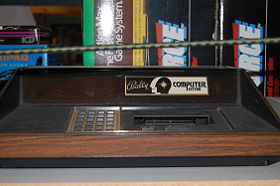- Astrocade
-
Bally Astrocade 
Hersteller Bally Typ Stationäre Spielkonsole Generation 2. Generation (8-Bit)  Veröffentlichung
Veröffentlichung1977 Hauptprozessor Zilog Z80 Speichermedien Module, Cassetten Controller 4 Multifunktionscontroller/ Lightpen Die Bally Astrocade, auch The Professional Arcade, Bally Computer System oder Astrocade, ist eine frühe, programmierbare 8-Bit-Spielkonsole der 2. Konsolengeneration von Bally, die von 1977-1985 vermarktet wurde.
Inhaltsverzeichnis
Technische Daten
- Prozessor: Zilog Z80 (1,789 MHz)
- 4 KB RAM, erweiterbar auf 64 KB
- 8 KB ROM
- Auflösung: 160×102 bis 320×204 Pixel mit 8 Farben (keine Sprites)
- Audio: 3 Stimmen, sowie Rauschen
- Mini-Tastatur mit 24 Tasten, auch für Spiele-Overlays, vollständige Tastatur optional
- Bis zu vier Controller mit Pistolentrigger, oben liegender Knopf dient zugleich als Joystick und Paddle.
Besonderheiten
Die Spielkonsole lässt sich mittels der ZGrass-32-Einheit in einen CP/M-kompatiblen Heimcomputer mit Tastatur erweitern (Abbildung). Mit einer BASIC-Cartridge, die, wie auch das Gerät selbst, 1980 von Jamie Fenton entwickelt wurde, können ebenso Programme selbst geschrieben werden. Zu den weiteren Besonderheiten zählen das innovative Design der Multifunktionscontroller und die verhältnismäßig hohen Grafikfähigkeiten.
Trotz der Überlegenheiten, konnte sich das System, wie andere auch, nicht gegen den Atari 2600 behaupten. Der Anfangspreis betrug 299 US$. 1979 verlor Bally 10 Millionen $ durch dieses System und verkaufte die Rechte an Astrovision[1]. Es gab weitere Namensänderungen und 1982 eine verbesserte BASIC-Version, bevor es 1983 zum Video Game Crash kam.
Spiele
Eingebaut waren vier Programme (Gun Fight, Checkmate, Calculator und Scribblings). Produziert wurden 45 Spiele auf Modulen (in Cassettenoptik) und ab 1980 weitere auf Cassetten. Die Spiele wurden als „Videocade“ bezeichnet.
Arcade-Verwendung
Die Sound-Hardware wurde auch in mehreren Arcade-Spielen wie Gorf und Wizard of Wor verwendet.
Fußnoten
- ↑ Burnham: Supercade, S: 168
Weblinks
Wikimedia Foundation.
